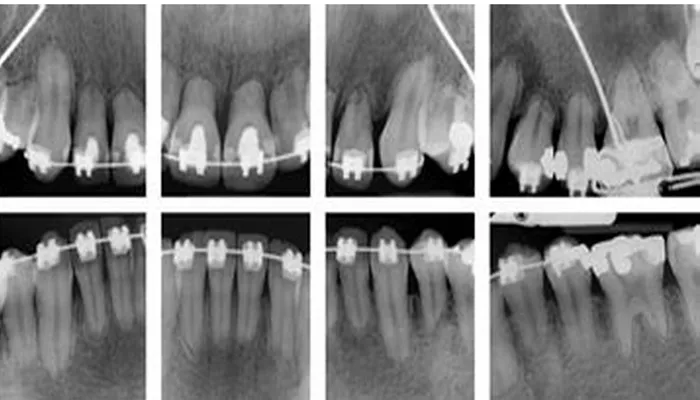Orthodontic treatment aims to create a beautiful and healthy smile by correcting misaligned teeth. However, one of the potential side effects of orthodontic treatment is root resorption. This condition involves the shortening or thinning of the roots of teeth during or after orthodontic procedures. While it is a relatively rare occurrence, root resorption can have significant implications for long-term dental health. In this article, we’ll explore the causes of orthodontic root resorption, helping patients and dental professionals better understand this complex issue.
What Is Orthodontic Root Resorption?
Orthodontic root resorption occurs when the roots of teeth start to dissolve, leading to their shortening or thinning. The process typically involves the breakdown of the cementum and dentin, the hard tissues that make up the tooth’s root.
Although mild root resorption is common during orthodontic treatment, severe cases can compromise the stability and longevity of the affected teeth.
Root resorption can be categorized into two main types:
External Root Resorption: This type of resorption affects the outer surface of the root and is often associated with orthodontic treatment.
Internal Root Resorption: This type affects the inner surface of the root canal and is less commonly linked to orthodontic procedures.
see also: How to Tighten An Orthodontic Expander
Causes of Orthodontic Root Resorption
Several factors contribute to the development of orthodontic root resorption. Understanding these factors can help orthodontists minimize the risk and manage the condition if it occurs.
1. Genetic Predisposition
Genetics plays a significant role in determining an individual’s susceptibility to root resorption. Some people are genetically predisposed to root resorption, making them more likely to experience this condition during orthodontic treatment. Studies have shown that individuals with a family history of root resorption are at a higher risk of developing the condition.
2. Orthodontic Forces
The forces applied to teeth during orthodontic treatment are a major contributing factor to root resorption. Excessive or prolonged force can lead to the breakdown of the root structure. The magnitude, direction, and duration of these forces are crucial in determining the extent of root resorption. Light, controlled forces are less likely to cause damage, while heavy forces can increase the risk.
3. Tooth Anatomy and Position
The anatomy and position of the teeth also influence the risk of root resorption. Teeth with irregular shapes, such as curved roots, are more susceptible to resorption. Additionally, teeth that are misaligned or rotated may experience higher levels of stress during orthodontic treatment, leading to an increased risk of root resorption.
4. Duration of Treatment
The length of time a patient undergoes orthodontic treatment is directly related to the risk of root resorption. Longer treatment durations expose the teeth to orthodontic forces for extended periods, increasing the likelihood of resorption.
Orthodontists must carefully plan and monitor treatment duration to minimize this risk.
5. Previous Dental Trauma
Teeth that have experienced trauma before orthodontic treatment are more vulnerable to root resorption. Dental injuries can weaken the root structure, making it more prone to damage during the application of orthodontic forces. Patients with a history of dental trauma should be closely monitored throughout their treatment.
6. Patient Age
The age of the patient can also influence the risk of root resorption.
Younger patients, whose roots are still developing, are generally more resilient to orthodontic forces. However, older patients, whose roots are fully developed, may be more susceptible to resorption.
Orthodontists should consider the patient’s age when planning treatment and adjusting forces accordingly.
7. Oral Health and Inflammation
Poor oral health and the presence of inflammation can exacerbate the risk of root resorption. Inflammatory conditions, such as periodontitis, can weaken the supporting structures of the teeth, making them more susceptible to resorption.
Maintaining good oral hygiene and controlling inflammation are essential during orthodontic treatment.
8. Root Resorption History
Patients who have previously experienced root resorption are at a higher risk of recurrence during future orthodontic treatments.
Orthodontists should take a detailed medical and dental history to identify patients with a history of root resorption and tailor treatment plans to minimize the risk.
Conclusion
Orthodontic root resorption is a complex condition influenced by various factors, including genetics, orthodontic forces, tooth anatomy, treatment duration, and patient age. While it is a relatively rare side effect of orthodontic treatment, it is essential for orthodontists to be aware of the potential risks and take preventive measures to minimize the likelihood of resorption. Careful treatment planning, regular monitoring, and patient education are key to ensuring successful orthodontic outcomes and preserving the long-term health of the teeth.
Patients should be informed about the possibility of root resorption and encouraged to maintain good oral hygiene, attend regular dental check-ups, and report any concerns during their orthodontic treatment.

